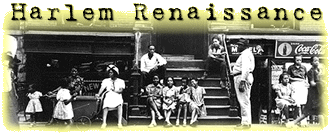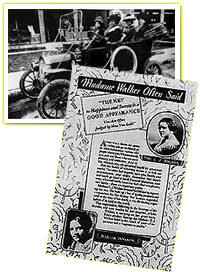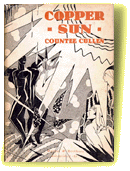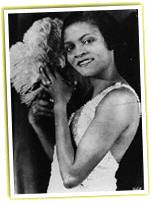
One of the many reasons people travel is to observe history -- tourists
wait for hours in line to see the names of their immmigrant ancestors
at Ellis Island. They visit castles or exhibitions of Egyptian
artifacts. But some historical eras are not well-marked by monuments
or museums. Their secrets dwell in the everyday streetscapes of
everyday neighborhoods. Take the Harlem Renaissance of the 1920s -- a
time of unprecedented cultural achievement for African-Americans.
These days it's hard to find evidence of the roaring twenties and the
fervor of what was called the New Negro Movement. Unless you have the
right tour guide, as did The Savvy Traveler's Marianne McCune.
Harlem Renaissance
By Marianne McCune
It's a Sunday morning, and Adams points me toward the
imposing facade of a neo-Gothic church near 138th Street and 7th
Avenue. An immense stained glass window looms overhead.
Adams: "Right here is the Abyssinian Baptist Church. It was
built by African-Americans in the early twenties."
Abyssinian is one of several nearby churches that helped
transform Harlem into a black community. On this day, hundreds
of well-dressed parishioners crowd into its wooden pews and join
hands to sing a century old hymn, written by a forefather of
Harlem's renaissance, James Weldon Johnson. "Lift Every Voice
and Sing" is sometimes called the "Negro National Anthem."
Butts: "I love to hear the spirituals sung in our church,
because they tell a story of our struggle."
Reverend Calvin Butts is the church Pastor and he welcomes
tourists and visitors to the church balcony. Here, you can
witness traditions that marry Harlem's history to its present.
Butts: "Shadowed beneath thy hand, may we forever stand true to
that god, and then it says, true to our native land. And what
is our native land? It's America. It's America."
When tour guide Michael Adams talks about the Harlem
Renaissance, his sometimes cynical eyes light up behind thick
glasses. As a gay, black intellectual coming of age in the
Midwest, Adams says he never imagined he could find himself in
history -- until he read about the black men and women who broke
all the rules to make Harlem their Mecca in the twenties.
Adams: "The thing that's so inspirational about the Harlem
Renaissance and about Harlem's emergence as a black community is
you know you've got all these people who see Harlem as an
opportunity to achieve their aspect of the American Dream. And
they don't act in a passive way to achieve that, they act
actively to bring about the transformation of this place into
their community."
We turn onto 139th Street -- a beautiful block of three and
four-story brick row houses, with polished wooden doors and elegant
cast-iron balconies. These were among the last houses in the
neighborhood to admit African Americans as residents. When the
stubborn company that owned them finally gave up its quest for white
buyers, Harlem's black doctors and dentists and otherwise well-to-do
flocked here -- even if it meant they had to take in boarders to
survive.
Adams: "Just as any school child, if you tell them don't smoke,
don't drink, it becomes the most irresistible thing in the world
to do."
With tiny, gated front gardens and back alleys for parking
cars, these houses became known as Striver's Row. Its residents
were striving to achieve America's middle class dream. This was
the heart of Harlem's new black community -- the so-called New
Negroes crowded into apartments all over the surrounding blocks.
Neighborhood resident Helen Brown remembers -- she had a room
in a yellow brick building on 142nd Street, the home of a widely
respected choral arranger (bring up choir music) named Hall
Johnson. Brown was a member of Hall Johnson's Negro Choir, among
the first to make spirituals popular beyond Harlem.
Brown: "We were to specialize in spirituals. And I never knew
what spirituals meant, because I was trying to do all the grand
opera, ha ha, like Lily Ponds and them would do."
As a boarder and a member of the choir, Brown met many of the
great intellects and talents of her time.
Brown: "They were all so very austere, and very grand, and very
magnificent, and very oh my, they were ultra ultra."
Writer Langston Hughes would never talk with his mouth full,
she says, even if it meant going hungry at a soiree. And poet
Countee Cullen's shirt was so stiff he couldn't see over it, as
Brown remembers it. Then there was singer Paul Robeson.
Brown: "I said, he looked like a Baptist preacher. And he had a
big roaring laugh, ha, ha, ha, ha, ha, ha."
But the Johnson home was only one of dozens of addresses
where Harlemites met to banter. Several blocks East, Adams and
I approach a humble red-brick apartment building. If you look
up before you cross 7th Avenue, you can see the letters YWCA
stenciled above, in weathered blue and white paint.
Adams: "Now this is one of the most important places of the
renaissance. Not only did Zora Neal Hurston stay here briefly,
and not only did they debut their poetry and literary
achievements, but also the restaurant there was the favorite
meeting place of the black literati of Harlem during the
Renaissance period, because food was good, reliable and
inexpensive."
 Photo from the Schomburg Exhibition Harlem 1900-1940.
Photo from the Schomburg Exhibition Harlem 1900-1940.
|
|
CJ Walker (inset: Walker's ad)
|
There's nothing in the main lounge but wood beam ceilings and
a dusty fire place -- the building is now a homeless shelter.
The only visible remnant of the history that unfurled here is a
small, iron plaque above a drinking fountain in the modern
offices next door. It commemorates Mme. CJ Walker, the first
black woman millionaire. She made her fortune selling hair
products.
Adams: "This is so incredible because, she taught black women,
who had the difficulty of how do they fit into this white
esthetic that they find themselves having to deal with, how they
could adapt their hair and stuff to that without being white."
Adams: "Now this building over here is another great monument of
the Harlem Renaissance."
The Renaissance Casino spans an entire block of Seventh Avenue,
right next to the YWCA. Its red bricks and painted tiles are
crumbling now, and its cavernous halls empty. But in the
twenties, bands like Chick Webb brought Harlem's finest to their
feet here.
The ballroom held thousands of people and gave Harlemites a
place to celebrate their birthdays and weddings, watch the
Harlem Rens play basketball, and dance their nights away to the
music that made Harlem swing.
Manning: "They had a ballroom on practically every corner in
Harlem, so you could go dancing at any time that you wanted to,
and it was always live music, big bands, and every night there
was nightclubs."
Unlike the New Negro intellectuals, Frankie Manning wasn't
interested in literature or high art. For him and for many of
his contemporaries, the music and dance of Harlem were what
defined its renaissance. Manning learned by watching his mother
and friends at rent parties -- parties Harlem's strivers held
when they couldn't quite get their rent together.
Manning: "The people was always laughing and joking and dancing
and laughing, and maybe one person would get out on the floor
and the others would get around, go ahead. It just seemed like
a happy thing to be doing."
Manning invented some of the so-called airsteps that made
Harlem's Lindy Hop world-famous. At the popular Savoy Ballroom,
he literally threw his partner.
Manning: (laugh) "In lindy hopping you pick her up quickly, and
you drop her quickly. You know,...when lifts you pick up, doo
doo de doo, like that. And lindy hopping you say, shoop boom,
yeah, ok."
Unfortunately, the Savoy Ballroom no longer exists. Most of
Harlem's dance halls and theaters have been replaced by grocery
stores or modern churches or parking lots or empty lots. But
there is hope for the graffiti-ed Renaissance Casino -- a
renovation is planned.
Adams: "And here behind you is another African American
landmark, an unlikely thing to be a landmark -- a funeral
parlor. The Rodney Dade Funeral Parlor."
You enter through a solemn, gothic archway under painted gold
letters.
Adams: "It was here in this space where the great, great singer
Florence Mills had her funeral."
Practically all of Harlem attended.
Florence Mills was beloved in Harlem -- for her flair and for
her rise to world fame as an African-American singer and
actress. Helen Brown remembers her return to Harlem after
several years spent performing in Paris.
Brown: "She wore a faded pink that was so marvelous. When she
walked down the steps with this trail behind her, she said,
parlez vous parlez vous parlez vous, oui oui oui. And everybody
had to stop. You could almost hear the breathing of everybody."
She died soon after -- and suddenly -- of appendicitis. The
Hall Johnson Negro Choir and about 600 others sang at her
funeral, and 200,000 mourners poured onto the now traffic-filled
blocks of 7th Avenue.
Adams: "And there are photographs where people are lined up on
the rooftops of these buildings to get a look at the Cortege
going by."
Brown: "When we came out from singing, there was a plane that
went over and let little black birds out."

|
|
Countee Cullen's Copper Sun
|
Before Michael Adams goes home to rest his vocal chords, he
takes me to the door of an angular red brick church on Seventh
Avenue. Salem United Methodist's pastor adopted and raised
young poet Countee Cullen, one of the few New Negro writers who
actually grew up in Harlem. Cullen is sometimes criticized for
trying too hard to fit a traditional, white aesthetic -- but
Adams defends him.
Adams: "Even if Cullen tried to speak in a voice that had
already been established by Keats or Shelley, he did it in such
a winning and incredible way. The economy and charm of his
little poem, She thinks that even up in Heaven, While her kind
sleeps and snores, Colored cherubs rise at seven, To do celestial
chores. And he's great!"
We peer into what are now the church offices: the dining
room where Cullen ate meals with his family and the study where
he must have toiled over his poems. Our footsteps echo through
the church auditorium below Romanesque arches -- where Cullen
was married to the daughter of the renowned black scholar W.E.B.
Dubois. Adams cold go on forever -- we've traveled fewer than
ten blocks, and he seems to find a little piece of history in
every nook and cranny. But it's almost dark outside and the
rest of his stories can wait for another tour -- Harlem's
history will still be here.
For More Information:
- To book a tour with Michael Adams, call 212-281-5802.
- Encyclopaedia Britannica has a thorough
section about the Harlem Renaissance on their website. Included
are leadership, literature, art and entertainment, presented in photo
galleries and multimedia clips.
- Check out Yahoo's listing of sites related to
the
Harlem Renaissance, and their directory of African American
museums.
- If you're in Harlem you might want to stop by the Schomburg Center for
Research in Black Culture. Their
holdings include photographs of some of Adams' heroes and they're
currently exhibiting the work of black New York artists of the
twentieth century. Phone: 212-491-2200.
- In Hartford, Connecticut, the Wadsworth Antheneum is featuring
selections from the Amistad Foundation Collection. Call 860-278-2670.





 Photo from the Schomburg Exhibition
Photo from the Schomburg Exhibition  Photo from the Schomburg Exhibition
Photo from the Schomburg Exhibition 